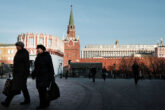June 02, 2022
Not Built for Purpose: The Russian Military's Ill-Fated Force Design
This article was originally published by War on the Rocks.
Russia’s invasion of Ukraine was a deeply flawed military operation, from Moscow’s assumptions about an easy victory, to a lack of preparation, poor planning, and force employment. Less attention has been paid, however, to Russian force structure and manpower issues as a critical element now shaping outcomes in this war. Plans rarely survive first contact with an opponent and militaries invariably must adapt, but strategic force structure choices can prove decisive. Force structure reveals a great deal about a military and its assumptions of what wars it plans to fight and how it plans to fight them.
The Russian campaign floundered not just because it pursued unrealistic political goals, but also because the plan for the invasion did not account for the choices made on force structure, and the limitations they imposed.
Some of the most significant problems being experienced by the Russian armed forces are the result of conscious choices and tradeoffs. These decisions help explain many of the observed struggles the Russian armed forces have had in combined arms operations, fighting in urban environments, and attempts to hold terrain. The full extent of Russia’s personnel weaknesses has become clear during this war. As it stands, the Russian military has a shortage of manpower — especially infantry. The Russian military also compromised by establishing a partial mobilization force. Consequently, the Russian army was optimized for a short and sharp war while lacking the capacity to sustain a major conventional conflict at “peace time” manning levels. The Russian armed forces are now pressed to sustain operations in Ukraine and attempting what amounts to a partial mobilization to stem the prospect of significant reversals on the battlefield.
Read the full article from War on the Rocks.
More from CNAS
-
Former NATO Secretary Explains: What’s Next for Venezuela?
The recent strikes leading to the capture of Nicolas Maduro have raised significant questions about the future of Venezuela. Jim Townsend, CNAS adjunct senior fellow and forme...
By Jim Townsend
-
Zelensky Heads to Trump Meeting with Canada, EU Support
Jim Townsend, CNAS adjunct senior fellow and ex-deputy assistant for European and NATO policy, joined CTV News to discuss the demands Zelensky faces from Trump. Watch the ful...
By Jim Townsend
-
Ukraine Negotiations: Prospects and Pitfalls of Peace
This week Brussels Sprouts breaks down the latest negotiations on Ukraine. American officials told reporters that they had resolved or closed gaps around 90 percent of their d...
By Andrea Kendall-Taylor & Jim Townsend
-
Can the Global Order Be Saved? Not Without Punishing Russia
The only way to succeed in the urgent task of achieving a just peace settlement, therefore, is radically reshaping Russia’s calculus....
By Nicholas Lokker




